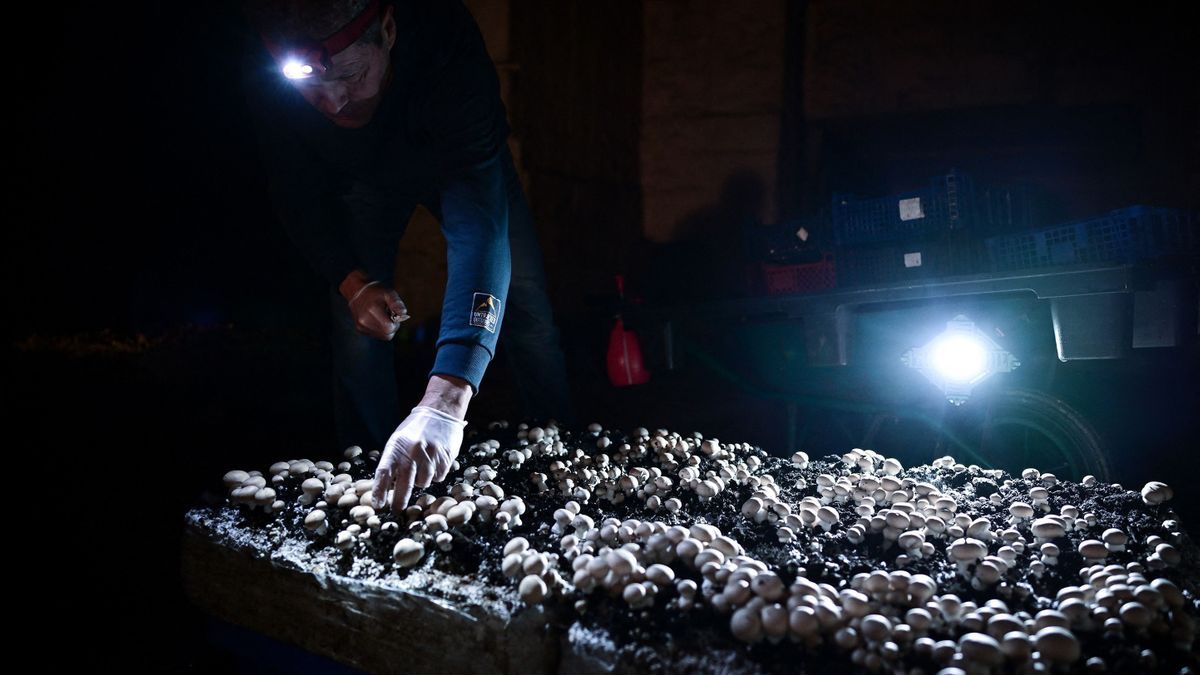
In the darkness of an old stone quarry or under the neon lights of an ultra-modern hangar, button mushrooms have found a favorable breeding ground in the south-west of Europe, symbols of the renewal of a national sector long battered by the foreign competition, particularly Polish.
Stable temperature and constant humidity, these so-called mushrooms grow a few meters underground, under the rectilinear vaults of a disused quarry in Saint-Germain-de-la-Rivière, in Gironde.
In this 20-hectare labyrinth, Laurent Disson has been harvesting organic mushrooms, oyster mushrooms and shiitake mushrooms since 2022.
“During the day, I’m a little alone, apart from a few bats“, laughs the fifty-year-old, manager of the Lo Champi Bio company.
“I really wanted to do something with my hands, to feed humans“, notes this former internet trader. “Customers are tired of eating mushrooms that are waterlogged, tasteless, don’t keep, don’t hold together when cooked. There is a return to quality“.
Lamp on his forehead and knife in hand, hunched over the compost substrates that he buys already seeded with mycelium, Laurent Disson picks 200 kg of organic mushrooms every week, all year round, and sells them for direct sale.
“Renewed interest”
A “relatively simple” culture and conducive to reconversions, according to Jean-Michel Savoie, of the National Research Institute for Agriculture (Inrae) in Bordeaux.
And the presence of quarries almost everywhere in Europe represents an alternative to cultivation in air-conditioned rooms.
“We see quite a few projects aimed at relaunching production in old quarries“, confirms Réjane Mazier, general secretary of the National Interprofessional Mushroom Association (Anicc), a sector which employs 2,500 employees for an annual turnover of 109 million euros.
Supported by a “renewed interest” from distributors for French origin, national production of fresh mushrooms is “regularly increasing”, according to this manager, going from 36,000 tonnes in 2000 to 40,000 today.
At the same time, total production of French mushrooms fell from 140,000 to 75,000 tonnes, due to the collapse of the canned food industry, with its share of closures and restructuring.
In Saint-Germain-de-la-Rivière, the quarry was occupied for thirty years by an industrial mushroom farm, relocated to Poland in the 1990s, says Laurent Disson.
State-of-the-art innovation
“We cannot compete with the Polish minimum wage,” summarizes Réjane Mazier. Poland represented 80% of the 45,000 tonnes of fresh mushrooms imported into Europe in 2022.
To remain competitive, other avenues exist: the company Cabane&Cie has invested 15 million euros in twelve state-of-the-art cultivation rooms in Parentis-en-Born (south-west), to reduce the arduousness of picking and double the yield .
In a 35 meter long shed, shelves filled with substrate tilt towards the picker to facilitate their movements, explains Vincent Audoy, co-founder in 2023 of this company with around a hundred employees.
The pickers, standing in mobile baskets, place the mushrooms on a conveyor belt, without heavy boxes to move.
“Without these efforts around arduousness, we would absolutely not be profitable“, confirms Vincent Audoy. “Certainly, the consumer is ready to pay more for a mushroom of French origin, but in the face of social dumping in certain countries, this is not enough. This new shelving system allows us to answer them“.
The company, which produces 45 tonnes of mushrooms per week for the regional market, generates 8 million euros in annual turnover and aims to ultimately produce its own compost to “reach a critical size”.
While waiting, perhaps, to deploy the artificial intelligence technology of a Swiss start-up to “point out which mushroom to pick“, enthuses Vincent Audoy.
